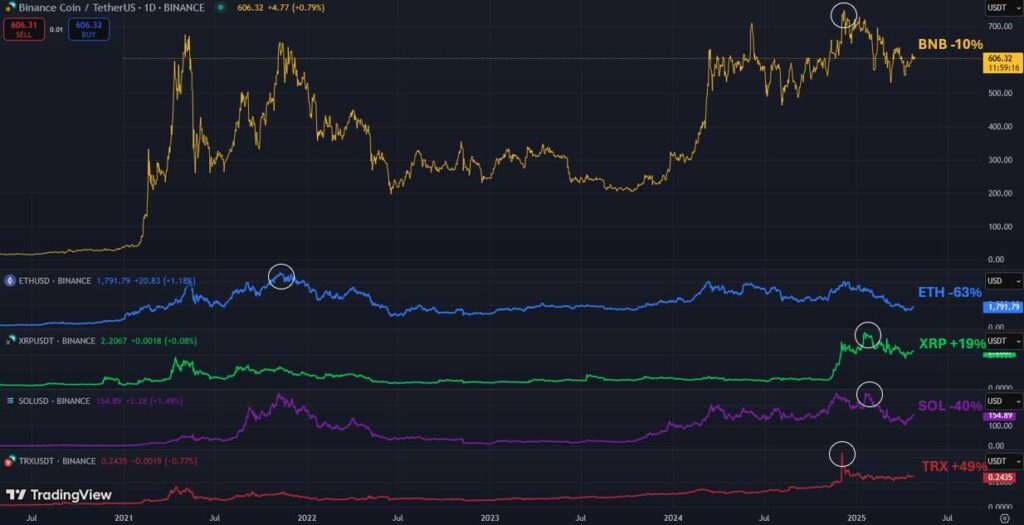The cryptocurrency landscape is teeming with activity as 2023 unfolds, showcasing a mix of hope and ongoing challenges, especially for altcoins. While Bitcoin continues to dominate investor attention, altcoins are beginning to show signs of resilience, with one standout being BNB Chain (BNB). Trading at around $89 billion in market cap, BNB has dropped just 10% from its all-time high during this cycle, a stark contrast to the significant declines seen in many of its peers.
Despite the overall sluggish performance of altcoins in the current market cycle, BNB Chain has displayed impressive resilience, consistently ranking among the top blockchains for daily transactions and active addresses. The recent surge in the total altcoin market cap, now at an encouraging $1.17 trillion, hints at a possible market rebound, with BNB at the forefront as one of its most stable players.
“While most altcoins have suffered drops of up to -98.5% from their all-time highs, BNB stands out alongside BTC as one of the least affected cryptocurrencies,” says João Wedson, founder of Alphractal, emphasizing the altcoin’s newfound strength.
What sets BNB apart is not just its price resilience, but also its thriving ecosystem. With nearly 5,700 decentralized applications (DApps) supported, the BNB Chain is a significant player in areas like gaming and decentralized finance (DeFi). While it ranks third in overall transaction processing, it lags behind in revenue generation compared to strong contenders like Ethereum and Tron, raising questions about its long-term sustainability.
As the cryptocurrency market continues to evolve, the strength and utility of BNB could play a crucial role in shaping future developments within the DeFi space. With larger implications for the adoption of Web3 technologies, BNB’s journey will be one to watch closely as it navigates both opportunities and obstacles on its horizon.
Insights on BNB and Altcoin Market Dynamics
The following key points highlight the current landscape of altcoins, particularly BNB, and their implications for investors and crypto enthusiasts.
- Altcoin Performance Relative to Bitcoin
- Altcoins have generally lagged behind Bitcoin in 2023-2026, driving traders to prioritize BTC.
- Despite this trend, the total altcoin market cap remains solidly above $1 trillion, suggesting a resilient overall market.
- BNB Chain’s Robustness
- BNB price is notably resilient, down only 10% from its previous all-time high.
- It ranks fifth among cryptocurrencies by market cap, showcasing a valuation of approximately $89 billion.
- Solid Ecosystem and Activity Metrics
- BNB Chain consistently ranks third in daily transactions and active addresses, indicating strong user engagement.
- It supports over 5,600 DApps, outpacing Ethereum, which has 4,987 DApps.
- Monetary Stability and Dilution Risk
- 96.51% of BNB’s supply is in circulation, reflecting a low dilution risk similar to Ethereum and TRX.
- This contrasts with Solana and XRP, which face higher future token inflation risks.
- Revenue Generation Concerns
- BNB Chain’s revenue from transaction fees is currently lower than competitors, amounting to $194 million.
- Its ranking has been consistently around fifth place among smart contract platforms, indicating room for improvement.
- Future Prospects Tied to Web3 Growth
- If Web3 adoption accelerates, BNB Chain’s DApp dominance could enhance its long-term sustainability and revenue potential.
- This might shift investor sentiment positively, especially if the platform continues to grow its ecosystem.
Implications for Readers: Understanding these dynamics is crucial for those interested in crypto investments, as the resilience of selected altcoins like BNB could provide formidable alternatives to Bitcoin, especially for long-term holders or those seeking diversifying strategies in a recovering market.
Unraveling the Resilience of BNB in the Altcoin Market
In a year where many altcoins have struggled, BNB Chain (BNB) emerges as a surprising contender, showing remarkable durability against the backdrop of Bitcoin’s dominance. Despite a challenging market cycle from 2023 to 2026, BNB is trading at a modest 10% below its all-time high, a notable achievement compared to many of its peers. This resilience is attributed to its robust ecosystem, which consistently ranks third in significant metrics such as daily transactions, active addresses, and total value locked (TVL). Yet, BNB faces a common vulnerability within the crypto landscape: revenue generation lags significantly behind industry frontrunners.
When examining BNB’s performance relative to competitors like Ethereum (ETH) and Solana (SOL), the narrative turns complex. Analysts have pointed out that while BNB displays relative strength, other coins such as XRP and TRX have substantially outperformed it year-to-date. For instance, BNB’s performance shows a mere 10% dip from its all-time high, whereas Ethereum has plummeted by 63%. This stark contrast in price action could position BNB as a safer investment choice for conservative traders, yet it may also lead to challenges in attracting speculative interest where potential gains drive market participation.
Another competitive edge for BNB is its low dilution risk, with 96.51% of its tokens already in circulation. This factor is crucial for investors looking for stability and minimal risk of future inflation. In contrast, tokens like Solana and XRP pose higher dilution risks, potentially skaring off risk-averse investors. However, this strength may not fully bolster BNB’s market position if its revenue generation does not improve. BNB Chain’s revenue ranks fifth among major blockchains, standing in stark contrast to Ethereum’s $2.5 billion and Tron’s $2.1 billion. This revenue gap could hinder BNB’s ability to innovate and expand its ecosystem further, ultimately affecting its performance in the competitive arena.
The blockchain space thrives on innovation and adaptability. BNB has carved out a niche in DeFi and gaming, showing promise with its developer-friendly tools and DApp offerings. With 5,686 DApps supported, BNB outstrips Ethereum, a factor that underscores its potential to capture a significant share of the burgeoning Web3 market. This positioning is likely to attract developers and users looking for reliable platforms for their digital innovations, creating an advantageous scenario for future growth. Conversely, this could also create friction with other ecosystems vying for the same narrative, particularly those like Solana, which also boast robust DApp ecosystems.
Ultimately, while BNB stands as a beacon of resilience in a stormy altcoin landscape, its shortcomings in revenue generation could hinder its long-term sustainability and innovation. This positioning may benefit cautious investors seeking stability amid volatility, yet it raises questions about how BNB will maintain its trajectory without solid revenue streams to back its ambitious ecosystem. As the crypto market continues to evolve, BNB’s ability to adapt and respond to these dynamics will be critical in determining its status within the altcoin hierarchy.
















